
Welcome, from sunny Australia!
My Starlet page
The plans for the three engines to go into
the Starlet

My Starlet page
The plans for the three engines to go into
the Starlet
There are a few other engines I'm going to
be fitting to the car, as time goes by.
4AFE
16 valve
The first engine to go into the Starlet was to be the 4AGE as has been
described on the previous page, however that plan has changed and now
the engine to stay in the
car long-term in a 4AFE, but it'll come out for the 7AGTE 20v engine
described
below for a while while I run that engine. More on that next section.
The head that I'm going to use is from the largely despised 7AFE. It's a long story but it turns out that there's three basic head types that the 4AFE & 7AFE in combination have. There's a very poor one that's by far the most common and they have rather small inlet ports that come out low on the inlet side and so the angles the air has to go through to get to the combustion chamber is extremely poor indeed. Those heads are boat anchors.
The first head of interest is quite common on the Aussie & other market 7AFE's, and they have two small inlet ports for each cylinder. They use the Toyota TVIS device to try to improve the low-end torque without sacrificing the top-end power. They have a lot more potential as the ports go into the head at a steep angle and so have the opportunity to flow a lot more air. The port angle into the head is similar to the 20 valve 4AGE, but of course they only have the two inlet valves. Both this head and the type above have the fuel injectors either in the head or remotely out in the inlet manifold. This head is the one I was going to use for the 4AFE project, but I found a much better 'F' head a few months later ....
The head in question is pictured below, and as you can see it only has a single inlet port per cylinder, but they also go into the head at a rather steep angle. This makes for a damn good inlet port for not a lot of work. Again there are two types for this head, but the variations are only relatively minor changes in the port bifurcation divider and bolt hole bumps in the port.
However, the combustion
chamber will need a lot of work to make it produce a lot of power. I've
looked at a lot of different types of engines and found certain
consistancies with squish areas that I will be using when finishing the
chamber. I'll also be trying some Formula One style tricks with the
chamber. This means a complicated piston top shape, and hopefully I can
get exactly what I want made. The exhaust ports will also need a lot of
work, but fortunately the work that needs to be done makes them end up
all the same gives them a very efficient shape. The other reason I want
to use this head is because they use 31mm diameter cam buckets, rather
than the smaller 28mm ones that the 16 valve 4AGE's use, and somewhat
larger than the 23mm ones the 20v heads use, so I can run a cam with
quite a lot of duration & lift without having the lobes run off the
sides of the buckets. I have found a standard 31mm Toyota bucket that
uses
no shims at all (it has a small 'stem' underneath that is trimmed to
the right length to get the right valve clearance) and so is very light
indeed.
Other things I'll be doing with the engine are - 7AFE block but still use a 4AGE crankshaft because that lets me run longer con-rods, (The 7AFE block is taller than the 4AGE) which reduces frictional losses and increase piston dwell time at TDC. Yes, they will weigh more than a shorter rod but I'll be getting the new ones made up at PAR Engineering in Sydney, though the weight will be largely offset as they're titanium.
The engine will also be
completed in three stages -
1. Wet-sumped with a Motec M4 Pro running four injectors that sit in
the
inlet manifold. This is mainly to set-up the engine and run it in
carefully, as I have less things to go wrong as it will in the final
configuration.
2. Dry-sumped, to improve power a little but also to make the engine
more reliable in competition as the oil flow will not suffer under
heavy braking and/or cornering. After a decade+ of fiddling with the
dry-sump systems used on my racing car, we have a pretty good idea of
how to build a good one. I have some plans for the system on this
engine that make it very simple and far fewer parts than they usually
have. This makes it lighter and hopefully more reliable. (and less oil
leaks!!)
3. The second set of four injectors to be fitted. The engine will end
up with eight injectors, four in the inlet manifold behind the throttle
butterflys and another four out in the end of the inlet trumpets. There
is a little more power to be gained by doing this, but it's complicated
and will take
some time to get right with the sequencing of primary and secondary
injectors. This is why I don't want to run the engine in
with it in this configuration as there is a greater chance of getting
it wrong and causing damage. It was also get a Motec M48 to run it at this point.
The con-rods, as I type this, are nearly done and are being made by a company down south. A friend of mine is getting an identical set of rods from them as well, and we've been waiting for well over a year for them now. Neither of us in very happy about this at all and while I'm not in any particular hurry for them, he has missed several important dates for the car as he can't put the engine together. We're getting them through a dealer closer to home and he's been fine, but I will not be doing business with that company down south ever again. The only reason we're sticking with them as the price is very good - especially for titanium rods - and as I type this, they're nearly finished. (I hope!)
This engine will be ready when it's ready. I plan to run it to 9,500rpm and although I'm expecting about 240hp from it, it should still drive as well as a standard engine does around town.
7AGTE 20 valve
The next engine I'm going to
build for the Starlet is a 1.8 litre 7AGTE 20 valve one. That's a 7AFE
bottom end, a 20 valve 4AGE head, and a 1998 Subaru WRX turbo. This
engine is just for fun, and although I do not favour the 20v head for
naturally aspirated engines I think they're a very good thing for
forced induction as the variable inlet cam timing should let the turbo
spool-up faster at low revs than what it otherwise would. They also
have more valve area than the 16v does standard, so that allows for
more air to be pushed into the chamber by the turbo. I have a set of
stock 4AGZE 8:1 compression pistons for it, but otherwise the bottom
end will be fairly standard. I only plan to run about 7,000rpm, so the
not-so-strong 7AFE rods should hold together well enough.
I have some sneaky plans for the intercooler (A water-to-air, but not conventional) and the way the turbo is mounted.
In the interests of keeping the rest of the mechanicals together, I have bought a bell housing that lets a 4A or 7A block bolt up to the very strong W series Toyota gearbox, and I also have a W-57 sitting at home waiting for it. I'm expecting up around 300 ft-lbs of torque and about 350hp from the engine, so there is no way a typical T-50 would take that and live. Same goes for the diff, I am currently hunting for a narrow Hilux 7.5" diff to put under the back of the car as they're very hard to break.
This engine is a low-budget one, and it's really just for a bit of fun. So it won't stay in the car, but will be sold at some point after it's been run for a while.
Suzuki V-6
Another
engine that I came across that should be a lot of fun to have in the
small car is the 2.5 litre Suzuki V-6. They're 85mm x 75mm bore &
stroke and I'm pretty sure that I can go out to an 88mm bore and so end
up with a 2.74 litre engine. They're all alloy and have a 60° bank
and so are quite light & compact. Good for the tight Starlet engine
bay.
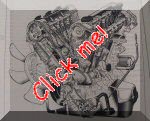 |
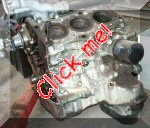 |
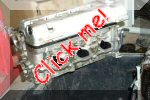 |
On the left
is a cut-away diagram from the factory manual. In the middle is is a
friend's two litre version and you can see that the sleeves that the
pistons run in are very thick indeed, thus there's good hope that a 3mm
over-bore can be done. On the right is one of the heads from that
engine and the very good inlet ports can be seen clearly here.
Estimated
Power Runs
Some estimated power runs,
using my trusty Engine Analyser Pro 2.1D & 3.3 'software dyno'
program. These
are runs based on older information I have, the latest ones show a bit
more power from the two planned engines.
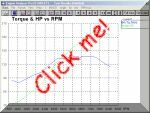 |
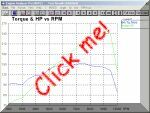 |
 |
 |
On the left is the 'plain'1587cc 16v 4AGE, the second is the 7AFE headed 4AGE (bored out to 1626cc), the third is the turbo 1762cc 7AGE with the 20v head, and on the right is the Suzuki 2737cc V-6.
Back to the Starlet page
For more motorsport links, try the motorsport section on my links page.
|
site owned by Bill Sherwood. |
|
|
Back to the Index page
Page & contents where applicable © Bill Sherwood